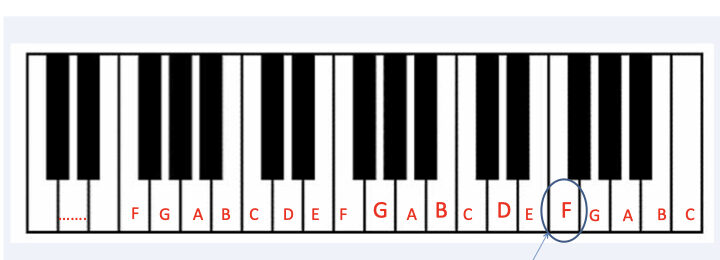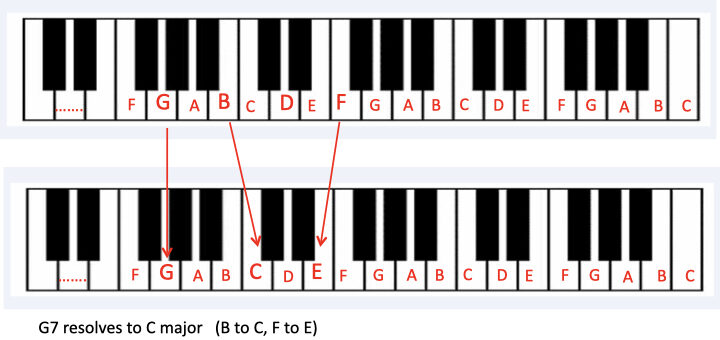Table of Contents
What is a ‘7’ chord ?
When we talk about a 7 chord, we mean a basic triad chord, which has had an extra note added, and that note is 7 steps away from the root of the chord. That note may or may not be in the key with the same name as the chord! Confused? Let’s start with the ‘scrabble bag’ approach.
Major 7th chord
Imagine a scrabble bag, which contains all the notes available in a key. If we are in the key of C major, then the notes are
C – D – E – F – G – A – B
If take the triad (basic chord) of, then the notes are C – E – G, which are notes 1, 3 andf 5, starting from C (or “play a note, Miss a note”). If we use the same process to add the seventh note away from C, then we end up with a B, so ourt chord is now
C – E – G – B
This is a ‘seven’ chord, because it contains a note whihc is the seventh step away from the root of the chord (which we count as ‘1’). if we play this chord, it has a slightly edgy, jazzy sound to it. Looking at the intervals between the notes, we can see that there is a semi-tone (or half step) between the 7 note (B) and the next chord note (C above the B). There are also 2 whole tones between the previous note in the chord (the G) and the B.
This chord type is known as a major 7th, because the 7 note is as found in the major scale that starts on the root. If that is a bit confusing just thinkl of the scrabble bag that we have used – C major scale. So the 7 note ins a C chord, uysing the C major scale notes, is a B, and that gives us the major 7th sound.
By convention, this chord is written as Cmaj7.
Dominant 7th chord
In the previoous section, we added a 7th note on to a C choird, in the key of C, and got a C major 7th chord. We can use the same technique, remaining inthe key of C, but this time starting on a G. The basic G traid i
G – B – D
If we count up another two notes, staying in the key of c, we end up with an F, as shown below.

The piano keyboard gives an excellent representation of what is going on here. We are in the key of C, so we are only using the white notes. To get to the 7th note away from G (where G is 1) we either count up 7, or use the “Play a note, Miss a note” technique.
If we play this chord, and compare it to the sound of the Cmaj7 chord that we played earlier, the two chords have different feels to them. The Cmaj7 sounds quite jazzy, while the 7 chord on the G sounds more rounded. If we look at teh make up of these chords we can see that they have a different makeup or formula.

Look at the relationship between the ‘7’ note and the chord root above. For the C chord, the B note is only a half tone away (there is nothing between the C and B) while for the G chord, there is a whole tone between the F and the G (there is a black key in between, so it is two half steps, two frets or a whole tone away, depending on how you think about it).
The chord on the G is obviously different in make up to the chord on the C so it can’t be a Gmaj7 chord. The name for this type of chord is a dominant 7th chord, so the chord is G dominant 7th. However, as this is the most common type of 7 chord, by convention, the ‘dominant’ adjective is dropped, so this chord would simply be referred to as G7.
Other 7 chords
So far we have looked at chords based on the 1st and 5th notes of the scale, which give us Major and Dominant 7th chords.
Minor 7th
Look at chords based on the 2nd, 3rd and 6th notes of the scale – e.g.
D – F – A – C

If we play this chord, it sounds different again to the major 7 and dominant 7 chords. Bothe the major and dominant 7 chords have the same spacings for the first three notes – e.g.
- Cmaj7 (C – E – G – B) : 2 tones, 1.5 tones, 2 tones
- G7 (G – B – D – F) : 2 tones, 1.5 tones, 1.5 tones
However the chord starting on D, in the key of C) has a different makeup, or formula to either of the above 2;
- Seven chord starting on the D (D – F – A – C) : 1.5 tones, 2 tones, 1.5 tones
The chord built on a D is a minor chord, and therefore this type of 7 chord is known as a minor 7th chord, e.g. D minor 7th (notated as Dmin7).
Minor chords (and therefore minor 7th chords) are found on the 2nd, 3rd and 6th degrees of the scale.
Diminished 7th Chords
If we build a chord starting on the 7th note of the scale, then we get the following in the key of C;
B – D – F – A
Looking at the relationships between the notes we get
- B to D : 1.5 tones
- D to F : 1.5 tones (note that this is different to a minor chord)
- F to A : 2 tones
We can hear that this is different to the major 7, dominant 7 and minor 7 chords, and that is because this chord has two minor (tone and a half) intervals at the start. This is known as a diminished chord, and therefore this is a diminished 7th chord, notated as Bdim7.
Resolving the dominant 7th chord
When we play a dominant 7th chord (e.g. G7, we can hear that it doesn’t sound finished, and wants to resolve. A G7 will normally resolve to a C – i.el chord 5 (V) will want to resolve to chord 1 (I), also known as the the root or home chord. But why is this?
If we look at a G 7 chords, the two notes that make it a G7 rather than a Gmin7 or a G maj7 are the B and the F, as highlighted below.

Remaining in the key of C (i.e. just using the white notes, if we take the B and the F and move them as little as possible, whilst remaining in the key of C (i.e. using just the white notes, we can move the B up one half step to become a C, and the F down one half step to become an E.

If we disregard the D note in the starting G7 chord, and play the veofre and after above we move from G7 (G, B, (d), F) to G – C – E, as shown below. And what chord is that? it contains C, E, and G – in other words C major chord.

Play that on a piano – you have heard that sequence countless times. It is the resolution of the V (5) chord to the I (one) chord, or more accurately V7 -> I, and is one of the building blocks of western harmony.
Its such a common progression that its easy to take it for granted, but take a moment to think about it.
- Start with any key (C major in this case)
- Play the V chord (G) and then add the 7th (G7)
- Move the third of that chord one half step higher and the 7th one half step lower, which is the smallest change we can make to that chord, and it transforms into the root or home chord
Try the above with any key and it works. For more about this progression, and the magic it unlocks, see the Circle of 5ths chapter.
Tri Tone substitution
It’s really outside the cope of this simple introduction to music theory, but I will just touch the surface of tritone substitution.
Take a G7 chord, and count the interval between the B (the 3rd of the chord) and the F (the 7th of the chord). Its 3 hold tones (B to C#, C# to D#/Eb, Eb to F). Now count the interval from the F to the B. Its also 3 whole tones (F to G, G to A, A to B).
The B and the F are the 7rd and 7ths respectively. They are also the 7th and 3rd respectively of Db7! (the B becomes spelt as Cb but its the same note/pitch).
- G7 : G – B – D – F
- Db7 : Db – F – Ab – Cb (Cb is the same as B)
This means that Db can be substitued for G in a progression to give a jazzy sounding sequence that works. Try it out, take any tune (Blue Ridge Cabin Home, and when you get to the 5 chord (G7 in key of C) play the substitution – the flattened 2nd chord (Db7 on the key of C)